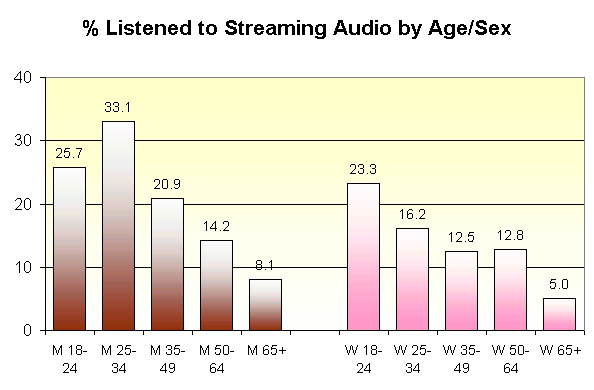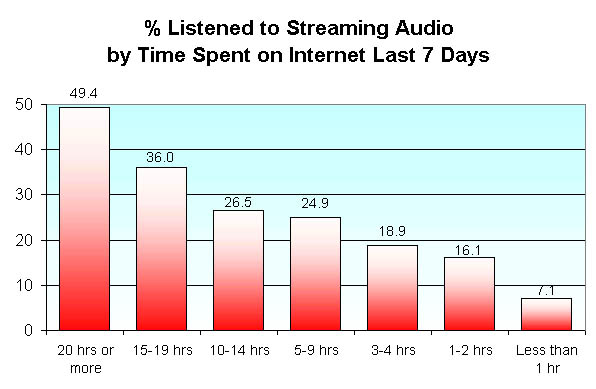
(Source: 2002 MARS OTC/DTC Pharmaceutical Study)
Streaming Audio Listeners
At this stage of the life cycle of the Internet, most websites are composed of text and image elements. Where sound is present, as in the form of bells, whistles or welcoming speeches, it is more often regarded as a nuisance. The exception is when a website provides streaming audio, either from a live transmission of a radio or television program or as dedicated internet news or music service.
Listening to streaming audio is not the perfect experience as yet, as most consumers have to consider some trade-offs. On one hand, a 56k transmission of music recordings may be less than perfect in pitch and tone, in additional to the periodical signal drops. In this sense, streaming audio does not match the quality of FM radio, not to say digital radio. On the other hand, the internet opens up a wide variety of options, literally coming from all over the world.
We will now cite some survey data from the 2002 MARS OTC/DTC Pharmaceutical Study. This is a survey of 22,097 adults in the 50 states of the United States of America conducted during the first quarter of 2002. Within this sample, about 60% claimed to have used the Internet within the past 30 days, whether at home, work, school or elsewhere. Among these Internet users, 18.7% (=22,852,000 persons) claimed to have listened to some form of streaming audio during the past 30 days.
In the next graph, we show the incidence of stream audio listening by age/sex. This medium is obviously much more popular among young people. For a given age group, it is also more popular among men than women.

(Source: 2002 MARS OTC/DTC Pharmaceutical Study)
The Internet is a multi-tasking environment, so that it is possible for someone to browse the World Wide Web, download files, check e-mail and still have a streaming audio source in the background. When one is performing some mundane routine that does not require much concentration, streaming audio is a way of breaking up the monotony. When headphones are used, it will not disturb anyone else around. In the next graph, we show the incidence of streaming audio listening by the amount of time spent on the Internet. The relationship is perfectly monotonic: the more time one spent on the Internet overall, the more likely one is to have listened to streaming audio.

(Source: 2002 MARS OTC/DTC Pharmaceutical Study)
Within these Internet people, 9.9% of them declared themselves as being Spanish/Hispanic/Latino in origin. Among the Hispanics, 18.6% of them had listened to streaming audio within the last 30 days. This incidence is not statistically signficantly from the general population. But among those who said that Spanish is the primary language within the household, the incidence goes up to 19.5%; and among those who said that Spanish is the secondary language within the household, the incidence is 23.9%.
(posted by Roland Soong, 5/19/2002)
(Return to Zona Latina's Home Page)